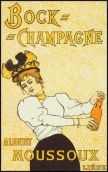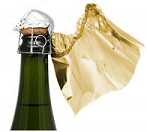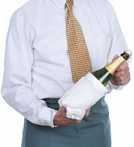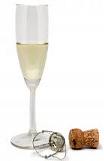|
The Feel-Good Guide to Sports, Travel, Shopping & Entertainment
|
||
| Main | Sports Events | Holidays & Observances | Pop Culture | Shopping | Travel |
|
Pop, Pop,
Fizz, Fizz...
There's no special talent needed to open a bottle of champagne or sparkling wine without injuring your guests. The secret is chilling the champagne and turning the bottle instead of pulling the cork. Here's a simple lesson...
It's important to have a chilled liquid. Champagne that is too warm will foam and spill when you uncork the bottle. You'll lose some of the bubbly and make a mess. Of course, it also tastes much better at the right temperature! You don't want to make it too cold though, or you'll lose some of the flavor of the wine.
Take the foil off the top of the bottle so that the wire cage is totally free of foil. There are two schools of thought on dealing with the wire cage. Some prefer to loosen it and others go all the way and remove it. The only danger to removing the wire protector entirely is that some bottles have enough pressure built up to have the cork pop when the cage is taken off. This shouldn't happen, but you may have shaken the bottle a bit too much while handling it...or if it was not stored in optimal conditions it may have built up a bit too much pressure while waiting to be opened. Leaving the wire cage in place will keep the cork in place until you're ready to remove it.
One thoughtful reader has also written in to suggest to mind any overhead obstructions - like chandeliers or light fixtures - which may be easily damaged by the force of a flying cork should things go awry!
Turn
the Champagne bottle Now, with your free hand get a good grip on the fat part of the bottle. Slowly turn the bottle while you hold onto the cork... don't give in to temptation and yank the cork when you feel it loosen. Just... gently... turn the bottle of sparkling wine or champagne until you hear a little "pop" -- this method doesn't make that loud noise that people associate with champagne on New Year's Eve. The noise comes from the carbon dioxide escaping. That's the gas that makes the bubbles. A loud pop means that you've let out too much of the gas - usually with a good bit of the champagne! The soft pop you'll hear means that you've preserved the bubbles in your champagne and you're ready to reveal your handiwork. Like a magician, whisk the towel away, still holding the cork, and present your guests with the opened bottle. Be prepared for the accolades. While this may be impressive, the next part is even better.
Wait for the initial foaming bubbles to subside, then pour again until about two-thirds of the glass is full. This method will avoid the mess of the foam spilling over the sides of the glass. Keep the bottle in the ice bucket whenever you aren't pouring. Drink the Champagne You can serve the champagne with oysters and crackers or fruit. Light cheeses are a perfect match. My grandfather's favorite was cutting up strawberries and adding them to the champagne in the glass. It gives the champagne a fruitier taste and eating the strawberry pieces is heavenly. Of course, if you intend to make a punch, mimosas or a fruit concoction, a less expensive brand of champagne is fine. You may even want to use a sweeter sparkling wine such as an Asti Spumanti. Check out the champagne cocktail and drink recipes our readers have submitted... Sabering Champagne Wondering about the names of different sizes of champagne bottles?
Champagne
is made for you to enjoy. So invite some friends, open a bottle of any size and have some fun! About the Author... Chiff.com Directory Editorial staff |
 Champagne
is not intended to be opened just for special toasts and important
occasions. The bubbly refresher complements any meal from brunch
to a midnight snack. It is a real treat just sipped by itself
especially when relaxing with a few good friends. A good champagne
can make any occasion memorable.
Champagne
is not intended to be opened just for special toasts and important
occasions. The bubbly refresher complements any meal from brunch
to a midnight snack. It is a real treat just sipped by itself
especially when relaxing with a few good friends. A good champagne
can make any occasion memorable.
 A good method
for making sure you get the right temperature is to fill your
ice bucket, or any deep container if you don't have a special
one for wines, and let the bottle sit for 15 to 20 minutes.
Adding just a bit of water to the ice in the bucket will actually
help cool down your bubbly. There's an explanation based on
physics and heat transference, but all you really need to know
is that it works.
A good method
for making sure you get the right temperature is to fill your
ice bucket, or any deep container if you don't have a special
one for wines, and let the bottle sit for 15 to 20 minutes.
Adding just a bit of water to the ice in the bucket will actually
help cool down your bubbly. There's an explanation based on
physics and heat transference, but all you really need to know
is that it works.  Loosen the wire
cage
Loosen the wire
cage Use
the towel
Use
the towel Pour
the Champagne
Pour
the Champagne